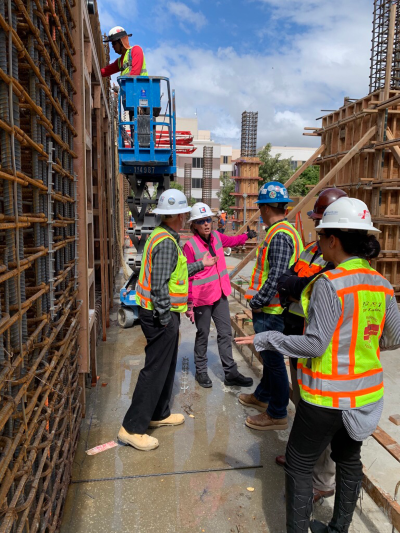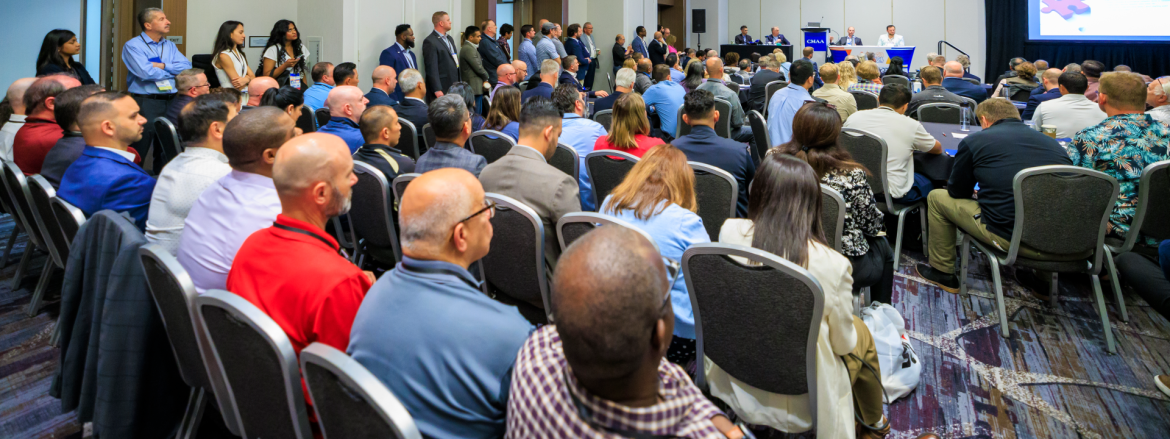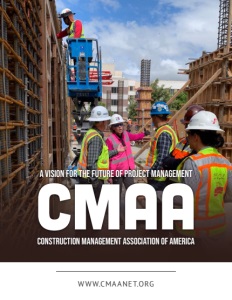A Vision for the Future of Project Management
Reshaping professional standards while preparing for tomorrow’s challenges
In an industry where precision meets innovation, the Construction Management Association of America (CMAA) plays an essential role in advancing professional standards and excellence across the built environment. With its sights set on becoming the definitive voice of the program and construction management industry, CMAA focuses on three core strategic objectives: promoting excellence in project delivery, shaping the profession, and serving as the premier resource for industry professionals.
“CMAA’s vision is to be the voice of the program and construction management industry and the premier resource to professionals working in the built environment,” explains Andrea S. Rutledge, CAE, President & CEO of CMAA. “We do that by educating, promoting, and developing program and construction management professionals.” Rutledge leads an organization that has built its reputation on three foundational principles: education, professional development, and credentialing.
Operating as a fully remote organization with its mailing address in Northern Virginia, CMAA maintains a strong presence across the construction management landscape. The association’s reach extends from individual construction managers to major corporations, encompassing service providers like AECOM and Jacobs, as well as owner organizations ranging from school districts and federal agencies to state departments of transportation and private companies.

CMAA’s Core Mission and Strategic Vision
At the heart of CMAA’s operation lies a comprehensive public affairs program that focuses on elevating the profession’s standards and ensuring its members’ expertise is recognized at the highest levels. “Our advocacy program resides in the executive office and focuses on advocating for the value of credential professionals,” says Rutledge. A key component of this initiative involves promoting the inclusion of CMCI credential holders in federal projects and programs.
The association’s advocacy efforts go beyond individual certification recognition, with CMAA actively working to protect qualifications-based-selection laws, including the Brooks Act, while pushing for the establishment of professional job classification series for program and construction management professionals within the Office of Personnel Management. This initiative aims to create a federal civil service job classification, further legitimizing the profession within governmental frameworks.
CMAA’s membership structure reflects its inclusive approach to industry development. “CMAA membership is open to anyone who is working in the program and construction management field broadly defined,” Rutledge explains. “Our open-door policy has created a diverse membership base that includes major service providers and owner organizations of all sizes.” From school districts and federal agencies to state departments of transportation and private companies, CMAA’s membership spans the full spectrum of program and construction management professionals.
The association maintains a delivery method-neutral stance, ensuring its educational and professional development programs remain applicable across all project types and methodologies. “This approach allows CMAA to serve as an unbiased resource for its members, focusing on best practices and professional excellence regardless of specific project delivery methods,” Rutledge says. Through this comprehensive strategy, CMAA continues to strengthen its position as a leading voice in construction management while adapting to meet the evolving needs of its diverse membership base.
The Critical Role of Construction Management
Construction projects demand meticulous oversight and coordinated management at every stage of development, requiring specialized expertise that goes far beyond basic project supervision. “Program and construction management professionals have roles and responsibilities from pre-construction all the way through post-construction, procurement, construction, all of it,” Rutledge notes. “There is a role and a set of responsibilities from start to finish regardless of delivery method.”
The value of involving program and construction management professionals early in the project lifecycle cannot be overstated. As Rutledge explains, “The construction management professional should be part of that conversation from the beginning. Because the earlier you are talking about the management of the whole thing, the more likely you are to get decisions made early when they need to be made instead of making them later when they are more expensive, or they lead to change orders.”
This early involvement directly impacts project outcomes, particularly in terms of financial and scheduling predictability. “The more planning you put in and the more collaboration you have at the beginning, the more likely you are to have price and schedule predictability,” says Rutledge. This systematic approach proves especially valuable when managing complex, multi-faceted programs.
Construction management covers a broad spectrum of competences. Rutledge illustrates this with a practical example: “A school district in the Pacific Northwest might have a multi-year bond for school improvement. That is a program that might involve a dozen schools over a period of five years.” Within such programs, individual projects might range from HVAC replacements and asbestos mitigation to new construction, all requiring careful coordination and management. “Such a systems thinking approach exemplifies how program and construction management professionals connect individual projects to broader program objectives, ensuring cohesive execution across multiple initiatives.”
Education, Credentials, and Professional Development
CMAA’s educational framework offers a comprehensive suite of learning opportunities designed to meet diverse professional needs across the program and construction management sector. The association provides multiple pathways for professional development, combining traditional in-person instruction with modern learning approaches. “We have a whole curriculum of education that can be offered in person. It can also be taken asynchronously by individuals in their own time, or we also offer it online or virtually in a synchronous format,” Rutledge says.
The association’s educational offerings include specialized courses targeting various aspects of construction management. “We have a full range of courses from our Professional Construction Management course to the Construction Management Principles course,” explains Rutledge. “The curriculum includes focused topics like ethics, negotiating, and scheduling, with a new risk management course in development.” Additionally, CMAA provides online modules aligned with their standards of practice and hosts bi-weekly webinars, which are recorded and archived for future reference.
CMAA’s conference program serves as another vital educational platform. “We have two annual conferences,” Rutledge notes. “One in the spring that focuses on engagement and interaction and developing the skills that you need as you rise in leadership in your organization, skills around contract administration and human resources and communications.” The fall national conference offers broader programming, featuring educational sessions, plenary sessions, and an expo.
The association takes pride in its ability to adapt to members’ learning preferences. As Rutledge points out, “People learn in different ways, and so we provide that learning opportunity to them in different formats.” This multi-channel approach to education ensures that program and construction management professionals can access professional development resources in ways that best suit their schedules and learning styles.
The Scope of Modern Program and Construction Management
The reach of CMAA’s membership cuts across every facet of construction, encompassing both vertical and horizontal projects in an impressive display of industry diversity. “We’re talking about all of it,” Rutledge emphasizes, describing a project portfolio that bridges office buildings, highway interchanges, tunnels, and bridges. This broad scope shows the essential role program and construction managers play in developing and maintaining critical infrastructure nationwide.
In the Washington DC area alone, CMAA members are actively involved in two major infrastructure initiatives. “We have two huge important projects coming online here,” Rutledge shares. “One is the Long Bridge replacement and supplement across the Potomac, and the other is replacing the Key Bridge in Baltimore, multi-billion-dollar programs that demonstrate the scale and complexity of work CMAA members oversee.”
The association’s approach to industry challenges is a nod to its practical, collaborative philosophy. When faced with specialized issues like cybersecurity, CMAA takes a strategic approach to member support. “One of the things that CMAA does really well is to do what it knows and redirect people to others who know better,” Rutledge explains. This philosophy comes into play in how the association handles specific member needs, often leveraging its extensive network to bring in subject matter experts.
The supply chain challenges that dominated industry conversations during the pandemic have largely resolved, according to Rutledge, though some specialized areas still face challenges. “We ask about supply chain, particularly for things that were hard to get in the pandemic or just took a really long time, and with a few exceptions for highly specialized equipment, the supply chain has smoothed out.”
Technology, Innovation, and the Future of ConstructionThe rapid evolution of technology has become a central focus for CMAA members, prompting increased attention to emerging tools and methodologies in the construction management field. “Our members are understanding the opportunities and implications of the rapid developments in technology,” Rutledge says. “The accelerating nature of technology and technologies is something our members are talking about and wanting to know more about, from artificial intelligence to virtual reality, augmented reality, drones, and LiDAR technology.”
CMAA has established a dedicated technology subcommittee to address these technological developments systematically. “We have a technology subcommittee that’s charged this year very specifically with exploring the opportunities and implications of this rapidly accelerating technology,” Rutledge explains. The committee examines not just what technology can do, but also its limitations, emphasizing what Rutledge calls “the human in the loop” – the critical ability to make judgments about technological outputs.
CMAA disseminates technological insights through multiple channels to ensure comprehensive member engagement. As Rutledge notes, “We do that through articles in our MCX. We do it through sessions at our conferences, we do it through webinars. We do it through our podcast because people learn in different ways.” This multi-channel approach helps ensure that members can access crucial information about technological advancements in formats that best suit their learning preferences.
The association’s approach to technology adoption reflects a broader philosophy about organizational effectiveness. This perspective aligns with Rutledge’s management insight: “I got some very good advice from my dad about the importance of listening and waiting.” She references author Margaret Wheatley’s concept about “the importance of tolerating chaos for the sake of the pattern that will emerge,” applying this principle to both technological advancement and organizational development.
Workforce Development and Future Direction
Workforce development remains a persistent challenge across the construction management industry, with CMAA taking a collaborative approach to addressing this longstanding issue. “Probably every association in the AEC (Architecture, Engineering, and Construction) industry is talking about workforce — needing more of it — and that is a constant that hasn’t changed in the 42 years that CMAA has been around,” Rutledge says.
CMAA has forged strategic partnerships to tackle workforce challenges, particularly in post-secondary education. The association maintains strong ties with the Associated Schools of Construction, advancing relationships with institutions offering construction science, management, and technology degree programs. Military transition programs represent another successful initiative. “We’ve been successful working with the Army Corps of Engineers, and most recently with the Naval Facilities Command in terms of transitioning individuals as they come out of military service into the civilian workforce,” Rutledge explains.
Looking ahead, CMAA has identified two primary focus areas for the immediate future. The first is centered on enhancing member experience quality. The second involves deeper strategic planning and consideration of industry-wide implications. As the organization moves into its next fiscal year, leadership is preparing to address substantial questions facing the program and construction management profession.
“We are always looking ahead, but sometimes we don’t give ourselves the luxury of time to think ahead and to consider what that future might look like and what it might mean for CMAA,” Rutledge reflects. “One of the things that our new board chair wants to do is to start considering some of these questions that could have long-term consequences, not just for program and construction management, but for the AEC industry.”
AT A GLANCE
Name: Construction Management Association of America (CMAA)
What: Professional association dedicated to advancing excellence in construction management through education, certification, and advocacy
Where: Headquartered in Northern Virginia
Website: https://www.cmaanet.org/


